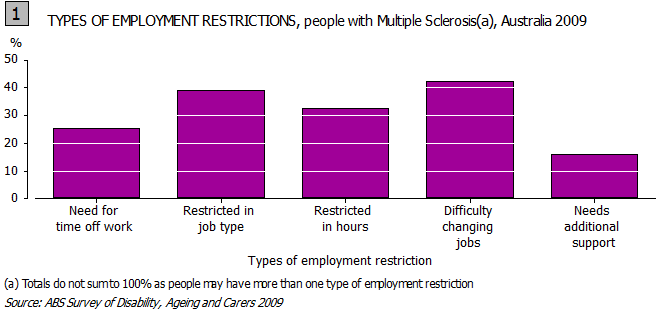MULTIPLE SCLEROSIS
WHAT IS MS?
Multiple Sclerosis (MS) is a disease of the central nervous system in which the myelin (fatty insulating sheathes protecting nerve fibres) becomes damaged and scarred. This impairs how well nerves conduct impulses, affecting a person's motor, sensory and even cognitive functions. The causes of MS are unknown, but genetic and environmental factors are suspected of having some role. The impact of MS on a person's ability to participate in everyday activities varies greatly from person to person.
HOW MANY PEOPLE HAVE MS?
In the Survey of Disability, Ageing and Carers (SDAC) 2009 there were estimated to be 23,700 Australians with MS (0.1% of the population) and of these, 11,400 (48%) had a profound or severe core-activity limitation.
Females were more likely to report having MS than males, with an estimated three quarters of all people with the condition being female.
MS affects more Caucasians than any other racial group (Endnote 1). In SDAC 2009, of all people with MS, 95% came from homes where English or European languages were the main language spoken at home.
ARE PEOPLE WITH MS IN THE LABOUR FORCE?
Dealing with the effects of episodic relapses means that it is sometimes difficult for people with MS to sustain employment. Of the 20,400 people with MS who were aged 15-64 years in 2009, an estimated 9,800 were employed, with 5,900 of those people being employed part-time.
Employment restrictions are significant for people with MS, both for those who are currently employed and those who are not in the labour force. An estimated 12,700 people with MS have some type of employment restriction (62.5%).
Graph 1 shows the types of employment restrictions people reported as a proportion of the total number reporting restrictions. People can report more than one type of employment restriction.

Of the people with multiple sclerosis 15,800 (66.7%) needed assistance with at least one of the ten everyday activities considered in SDAC 2009. The most common was assistance with mobility, with 46% of people with multiple sclerosis needing assistance with mobility tasks.
MORTALITY
Multiple Sclerosis was identified as the underlying cause of a very small number of deaths (32 males and 100 females) registered in Australia in 2010. MS was also reported as an associated (multiple) cause of 237 registered deaths (62 males and 175 females) in that year (
Endnote 2).
ENDNOTES
1.
The Multiple Sclerosis Society of Australia, 2012 , MS The Mystery Disease (Revised 7th edition), viewed 25 June 2012, <
www.msaustralia.org.au>
2.
Australian Bureau of Statistics,
Causes of Death, Australia, 2010 (cat. no. 3303.0)
 Print Page
Print Page
 Print All
Print All